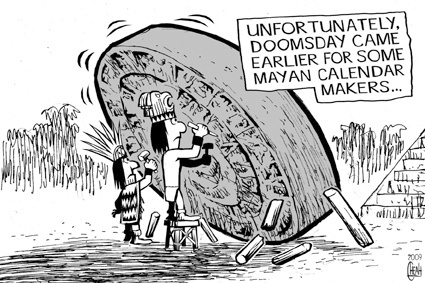In class with Dr. Housefield, we have spent a lot of time discussing comics. However, I'd like to branch out a little and talk about cartoons and how text is implemented within them. After reading Scott McCloud, we should all understand the difference between comics and cartoons; but I'll just explain the main point. Comics are juxtaposed sequential images, whereas cartoons have singular panels. So how does the use of words differ between the two? Well think about it, they have different functions. Comics tell a narrative, a story; cartoons are images, often over simplified, that are intended to be a humorous comment or satire (according to the dictionary definition). Thus, in comics, text typically helps
move the narrative along. In cartoons, text is a quick jab, explanation, or comment.
The above image is a cartoon; it is a single image that makes a humorous comment or stab at an idea. Here, we see members of the ancient Mayans crafting the famous Mayan calender that ends in 2012. While many believe that since this calendar ends in 2012, it marks the end of the world. Obviously, the artist of this cartoon does not believe this, and came up with his or her own "explanation." The text explains what the image means, because without it, we the viewer wouldn't know what the subject matter is really revealing.
Now this image above shows a comic. The text is used to move the story along. There isn't a short, quick explanation of everything, there is no underlining commentary on the subject matter. However, what we do see is words progressing and moving the story forward.


No comments:
Post a Comment